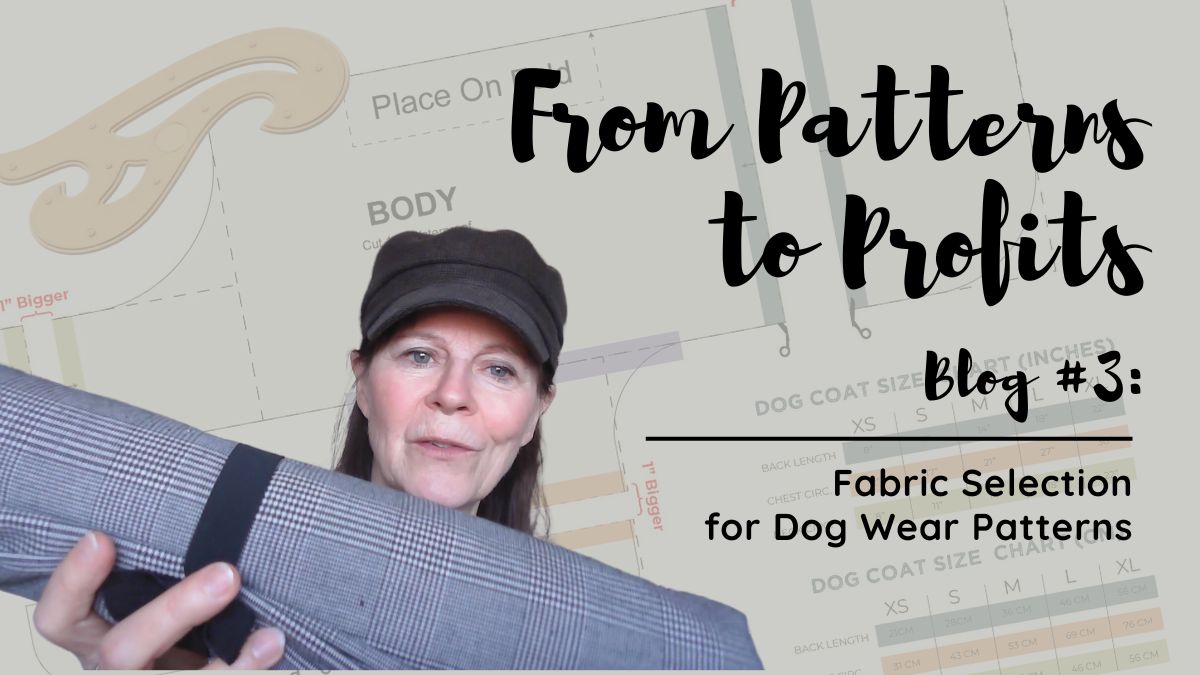From Patterns to Profits: Fabric Selection for Dog Wear Patterns

Discover the best fabrics for dog wear patterns and learn key tips on fabric selection for comfort, durability, and eco-friendly designs.
Different Season Different Fabric
When designing dog wear patterns, I always think about the season the garment will be used in and what fabric will best suit the fit and comfort of the dog. Whether I’m designing a cozy winter coat, a lightweight rain jacket, or a cooling jacket for the summer, the fabric choice impacts the garment’s fit, feel, and performance. Understanding basic fabric characteristics helps you create instructions that guide your customers toward the best fabric options for their projects.
Let’s explore why fabric selection is so important.
Why Fabric Recommendations Matter
The fabrics you recommend in your pattern instructions can make or break the final product. The right fabric ensures comfort, durability, and functionality—tailored to the specific needs of the garment and the dog. For example, a pattern for a raincoat should specify water-resistant fabrics, while a hoodie pattern may suggest soft, breathable jersey fabric for comfort.
Beyond comfort and functionality, fabric recommendations also influence how easy (or challenging) your pattern will be to sew. Some fabrics are easier to work with, while others may require more advanced sewing techniques. Giving your customers fabric suggestions can set them up for success.
I still remember my first dog coat, which I made with outdoor furniture fabric. Huh?! What was I thinking? The result was stiff and uncomfortable. I quickly learned the importance of understanding fabric properties when designing patterns that others will use.
For a deeper dive into some of my favourite fabrics and why I recommend them, watch my video here.
Key Factors to Consider
When developing a pattern, it’s essential to recommend fabrics that suit both the design and the needs of the dogs wearing the garment. Here are a few key factors to consider:
Comfort and Breathability: For warmer weather, suggest lightweight fabrics like cotton or bamboo. For winter patterns, materials like fleece are great for providing warmth.
Durability and Strength: For outdoor or active wear, durable fabrics like canvas or nylon should be recommended for their ability to withstand wear and tear.
Water Resistance: Rainwear or outdoor gear requires water-resistant fabrics, such as PUL or oilcloth.
Ease of Cleaning: Garments that will be worn regularly, like coats or sweaters, should be made from machine-washable fabrics.
Sustainability: Eco-friendly fabrics are becoming increasingly popular. Consider recommending sustainable fabrics like organic cotton, bamboo, or Tencel, or even suggest sourcing fabrics from dead stock resources, where unused textiles are made available to makers.
Popular Fabrics to Include in Your Recommendations
Here are some commonly used fabrics and why they may be suitable for your dog wear patterns:
Fleece: Warm and lightweight, great for winter coats or layering.
Cotton: Breathable and comfortable, ideal for casual or indoor garments.
Nylon: Durable and water-resistant, perfect for lightweight raincoats.
Canvas: Heavy-duty and long-lasting, good for rugged coats. However, canvas can be stiffer to work with and may require more advanced sewing techniques.
PUL (Polyurethane Laminate): Water-resistant and lightweight, ideal for raincoats and outdoor gear. PUL can be a bit tricky to work with, requiring special sewing techniques, which I’ll cover in more depth in my course.
Tips for Including Fabric Recommendations in Your Pattern Instructions
Consider the Climate: Be specific about which fabrics work best for different weather conditions in your pattern instructions.
Match the Fabric to the Design: Ensure your fabric recommendations align with the intended use and style of the garment.
Include Layering Suggestions: If your design involves layers, recommend fabrics that work well together or techniques to manage tricky combinations, such as combining stretch and non-stretch fabrics.
Test the Fabric: Test your fabric recommendations to make sure they meet your standards for comfort, durability, and ease of sewing.
What’s Next?
In my upcoming course, I’ll go deeper into fabric selection and show you how to pair fabrics with specific designs. You’ll also learn advanced techniques for working with different materials and ensuring the perfect fit. If you want to dive into these details, check out my course "From Patterns to Profits: Digitize, Grade & Market Your Dog Wear".
In the meantime, experiment with different fabrics to build your confidence in selecting the right materials for your designs. If you haven’t already, download the guide on accurate dog measurements. Combined with the right fabric selection, these skills are key to mastering dog wear design.
Stay tuned for more insights and practical advice!
Categories: : Sewing
Get a Step-By-Step Guide and Workbook
Do you need help measuring your dog? Download my 4 Steps to Fit Your Dog Guide and Workbook and I’ll walk you through the step by step process to take all the measurements you need to make a simple dog coat your dog will love! There's even a video you can watch that shows you exactly how to do it!
Join My Mailing List
Sign up to be the first to know about exclusive offers, free tutorials, and new product updates.
I have read and agree to the terms & conditions.

 Jill Bartlett
Jill Bartlett 
